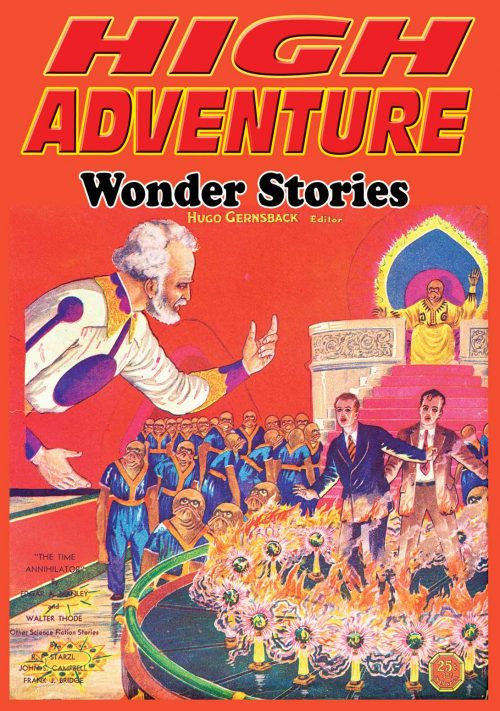Magazine Review: High Adventure #168: Wonder Stories edited by John P. Gunnison
This issue of pulp reprints gets its content from Wonder Stories November 1930 (when it was still edited by Hugo Gernsback) and Thrilling Wonder Stories December 1942 (after Gernsback had been bought out by the Thrilling Group.) As you might imagine, this means we’re in for some pulpy science fiction tales.

“The Time Annihilator” by Edgar A. Manley and Walter Thode leads off with a reporter and lawyer discovering that their scientist friend has created a time machine. They’re skeptical at first, until he launches off into the future, but then the machine returns without him! Time to mount a rescue.
Following a small clue, they wind up in 2418 and are dismayed to learn that homo sapiens has been wiped out by a race of artificially created super-humanoids. By what seems at first pure coincidence, the future beings speak Tibetan, which the reporter learned on assignment, and the arrival coincides with an anniversary celebration where the history of the race is ritually repeated.
The protagonists are captured by the future beings, and are about to be put to death by a bizarre superscience contraption when it turns out there’s another time traveler present. He manages to get into the time machine and save our heroes. The cover is pretty accurate here, with the rescuer appearing out of thin air.
The newcomer explains that he’s from approximately halfway between their era and that of the future beings, and had been picked up by the scientist to do some exploring only to be stranded in that dismal future. With his guidance, the trio can now get back to the day of the takeover and rescue the scientist.
Reunited, the friends drop off their colleague and attempt to stop the genocidal mad scientist from creating the humanoids in the first place. No luck, as it turns out the timeline is immutable. Their time journey was foreordained and their failure to save the human race inevitable. They can only leave records and live their lives as best they can.
“The House in the Clouds” by Ulf Hermanson has an aviator accidentally discover the aerial hideout of an engineer that has developed practical anti-gravity. The engineer and his colleagues have decided not to give humanity this gift until they think it’s time. The aviator decides to use force, and the secret is lost.
“The Invulnerable Scourge” by John S. Campbell starts with an entomologist betting one of his colleagues he can through selective breeding create an insect with no natural enemies, resistant to any form of control known to science. He proves his point, but the specimens get loose and have explosive breeding capacity. Soon the world’s land plants, and thus animals and humans, are doomed to extinction, unless the professors can come up with a countermeasure in time. A tense tale somewhat marred by having the colleague speak in a funny foreigner accent. Content note: discussion of suicide.
“Lords of the Deep” by Henry F. Kirkham is a “lost race” story, which uses the annoying cliche of “these monuments could not possibly have been built by the primitive natives, so someone else must have done it.” In this case, it’s the heads of Easter Island. Turns out there’s a subterranean Phoenician civilization below the island that’s sealed itself off for centuries. Our explorers arrive just in time to get involved in a civil war.
There’s some great moments in here, including a bit where our main character must impersonate a goddess because it’s the only role left and he’s the only non-bearded man. But the person who saves the day because of her love for our hero and becomes his wife…never gets dialogue or a name, despite clearly being able to speak!
“Hornets of Space” by R.F. Starzl has a passenger liner attacked by space pirates near Eros. There’s a contingent of Interplanetary Police on board with one man fighters, but the pirates have a superior force field. It’s up to one man branded a coward to defeat the foe!
That story is followed by a science quiz which mentions the social organization of Piltdown Man. Then on to the 1942 stories!
“Tubby–Time Traveler” by Ray Cummings is the story of Tubby, who’s bored in a lecture about how future humans will be brainy wimps. Suddenly he’s accosted by a scientist who needs a strong fellow to travel through time to save a girl. It’s a humorous tale with Tubby convinced he’s in the future when it’s clear he’s actually in the prehistoric past, but the ending falls flat.
“Martian Heritage” by Barry Cord finishes the issue with two explorers trying to find a third in the cold swamps of Mars. What they find is a stirring epic of the vanished Martians, and what the humans owe their extinct neighbors. It’s a somber but hopeful note to end on.
This is a so-so issue; maybe check to see if your library has a subscription?

